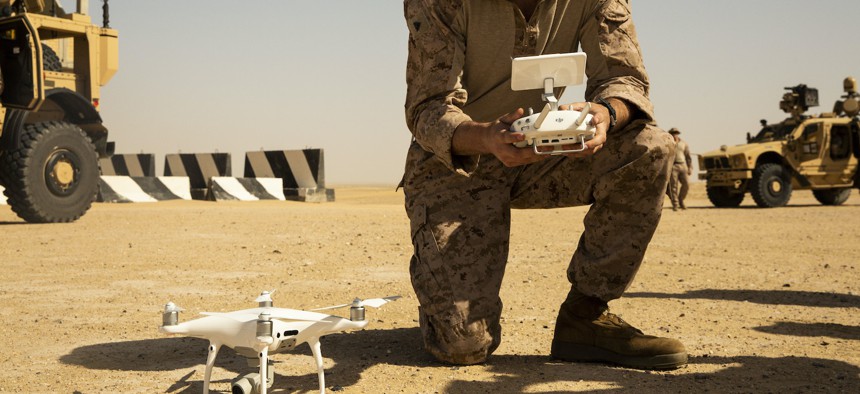
U.S. Marine Corps Cpl. Ryan George prepares to pilot a drone-target during a live-fire range in southwest Asia, Feb. 17, 2019. U.S. Marine Corps / Lance Cpl. Jack C. Howell
Job 1 for makers of anti-drone defenses: write good software
Pentagon buyers are looking for control systems that are reliable, easy to use, and simple to update.
Military buyers really, really want counter-drone systems that work—starting with the software that drives them.
“As threats change, and different threats show up in different form factors—let's say swarming [drones] versus individuals—how will your software adapt to that? How and how can a marine up in the field download that?” said Stephen Bowden, U.S. Marine Corps’ program executive officer for land systems, during a panel Wednesday at the National Defense Industrial Association’s conference on emerging tech. “Does a field service rep have to come out and plug in and then do an update? That's not going to necessarily work very well in the first island chain.”
The Marines aren’t alone.
“If you're looking to work with the DOD on counter [unmanned aircraft systems], think about the software aspect that drives the hardware,” said Lt. Col. Gabriela Arraiz, deputy chief technology officer for Joint Special Operations Command at the same conference. “If there is a new radar or a new camera or a new sensor that you'd like to integrate and utilize, you have to be able to add it to the current suite of offerings…it can't be this massive, cumbersome process. And so that goes back to the software.”
And that challenge isn’t only for counter-UAS weapons, Arraiz said. It extends to Joint All Domain Command and Control, the Defense Department’s effort to make seamless communications between systems, services, allies, and partners.
“We must sense, make sense, act, across all phases of war, across all domains, and with our partners,” Arraiz said. “And what we discovered was that the counter-UAS problem set and the challenges that we are experiencing today in this space are a microcosm of the challenges that the JADC2 initiative will also experience.”
Both missions require “getting systems to talk to one another, getting sensors to send data, getting access to that data, being able to use it to make decisions.”
And all of that takes good software to make sense of data and share it quickly so commanders can have as much time as possible to make a decision: “am I kinetically defeating? Am I deterring? Am I doing something else? Am I leaving my base entirely?”
Arraiz said tech companies should readily share things like data dictionaries, programming interfaces, and API documentation.
“It isn't really emerging technology that we're after here. It's technology that works with other technology and sometimes the challenge is how do you make something that's modern work with something that's very old,” she said.
Joint Special Operations Command is also experimenting with automation and autonomy, Arraiz said. There are still questions about when to use autonomous systems and how much to trust them. But she said she could see a use for “automation and eventually autonomy” in, say, defending against incoming drones.
“Those are kind of some of the things that we see coming very near in the future of conversation,” she said.




